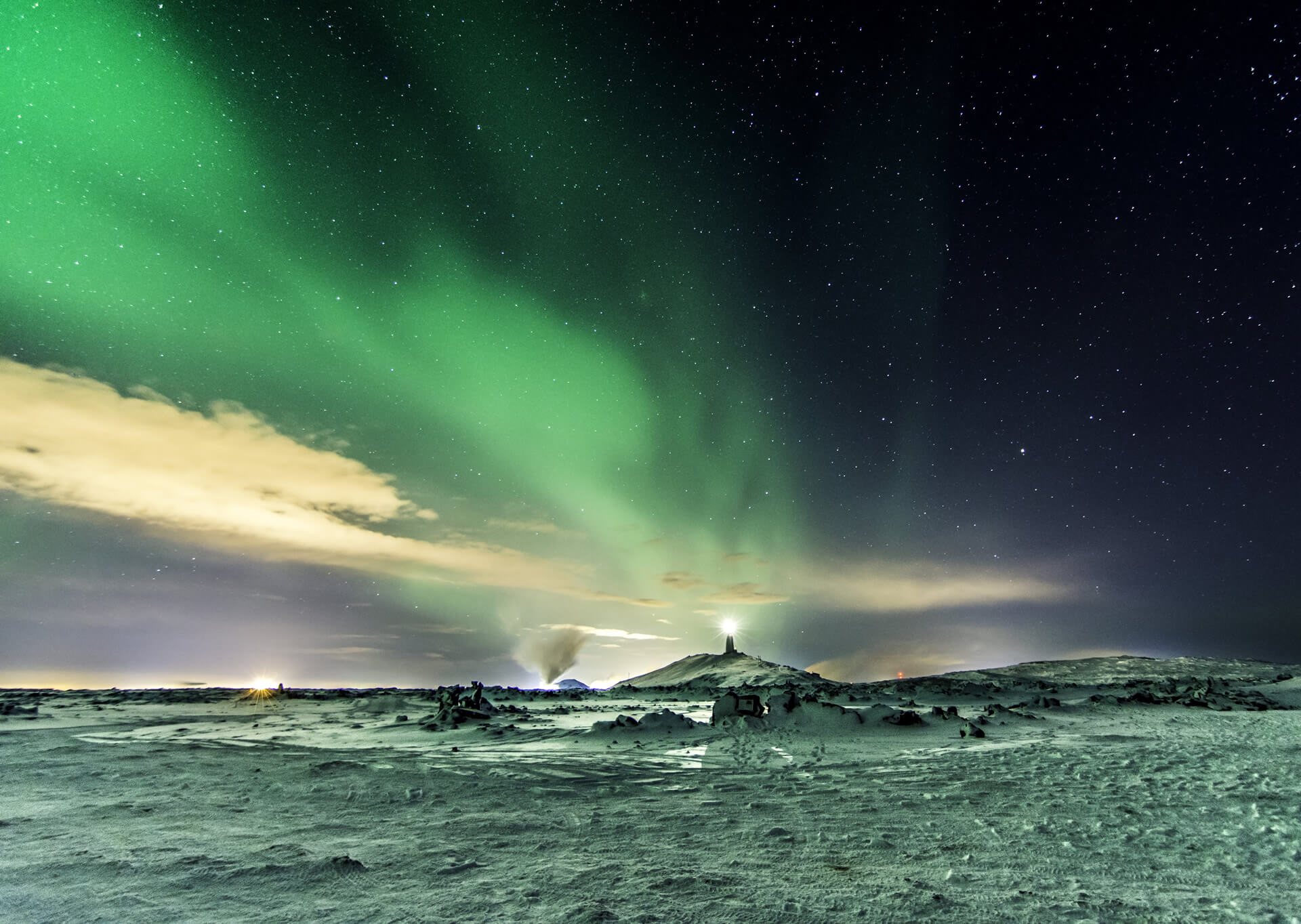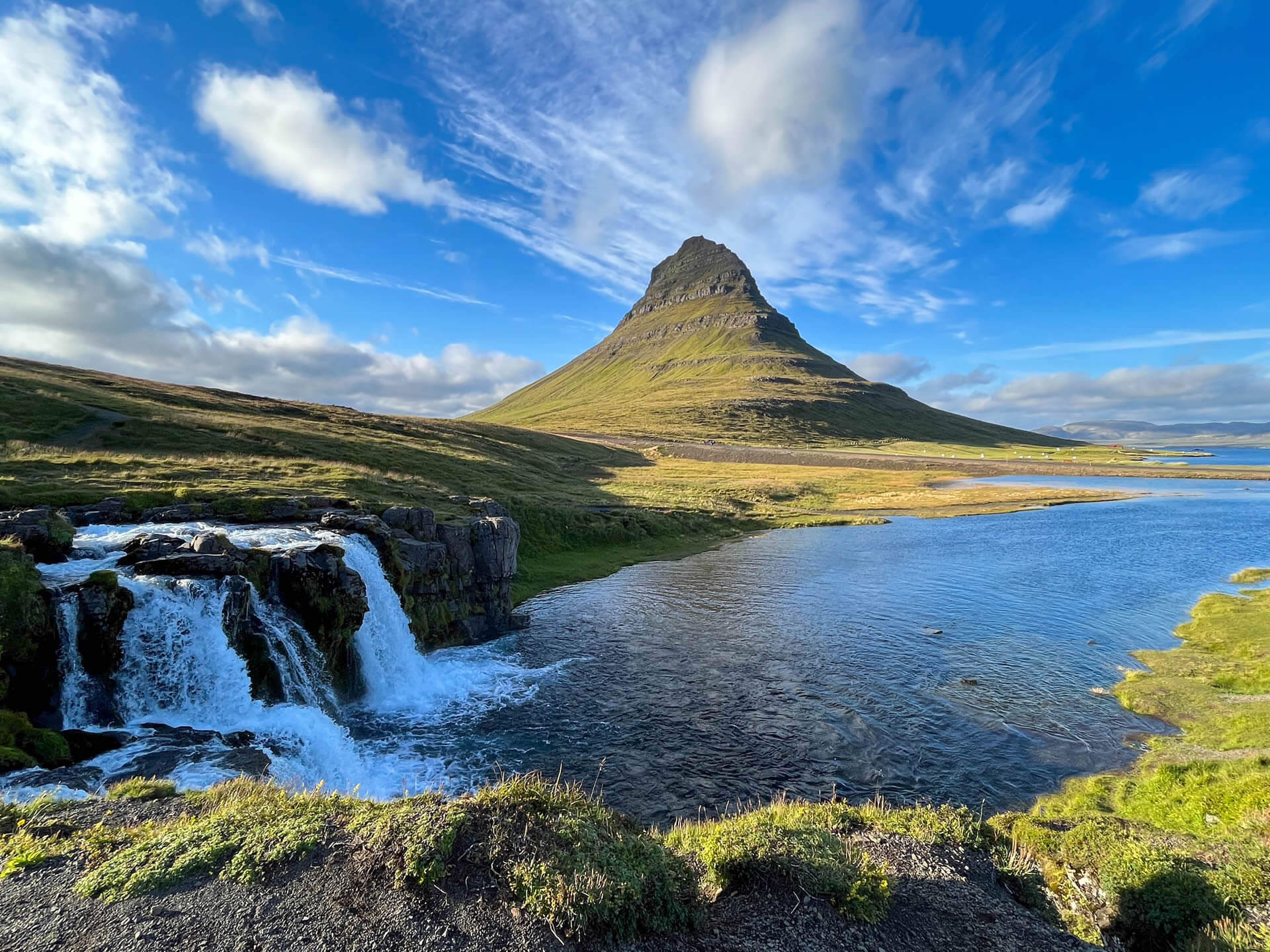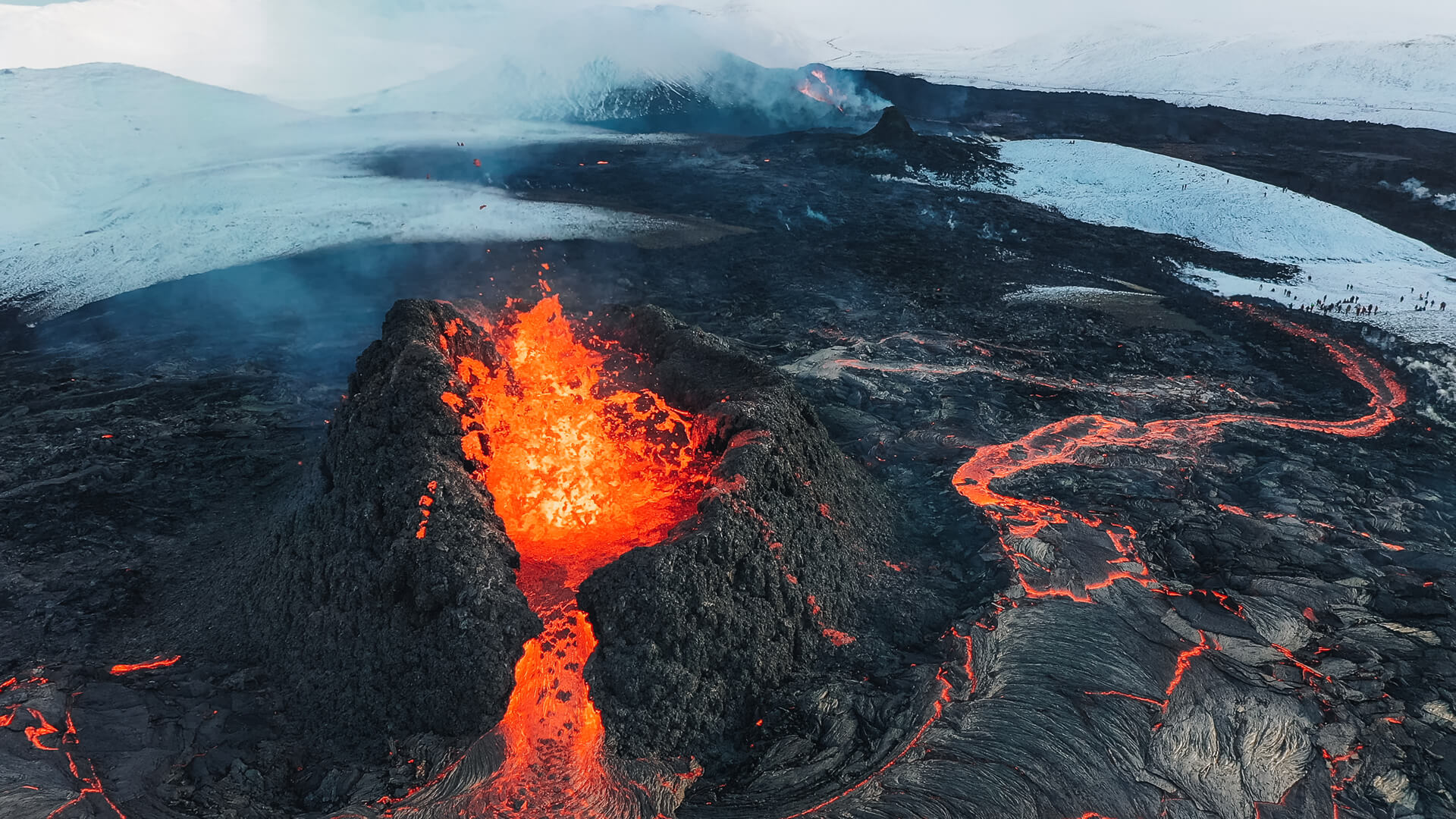
Mastering the Art of Capturing Nature’s Fury: How to Photograph a Volcanic Eruption
P
hotographing a volcanic eruption is a thrilling and rare opportunity to document Mother Nature’s raw power and beauty. However, it is crucial to approach this awe-inspiring event with careful planning, safety precautions, and a deep understanding of the volcanic environment. In this article, we go over the key steps and techniques to photograph a volcanic eruption safely and creatively. We provide safety advice, prepare for long hikes and unpredictable weather, give camera handling tips, and offer drone and aerial photography insights.
Safety first
Safety is paramount when embarking on a photo expedition near a volcanic eruption. To ensure your well-being, learn about the volcano’s activity and recent eruptions. Keep up to date with official notices and warnings from local authorities.
Volcanic eruptions are often preceded by increased seismic activity in certain areas, which provides valuable clues to possible eruption sites. For example, the recent eruption of Litli-Hrutur on the Reykjanes Peninsula could be accurately predicted thanks to the recording of around 10, 000 tremors in the days leading up to the event.
However, the unpredictability of new eruptions and the presence of potentially toxic gases require caution. Always adhere to safety parameters, designated access points, and evacuation zones. Even though the spectacle is captivating, avoid getting too close to the flowing lava. Remember that reckless behaviour not only endangers your life, but also the lives of rescue workers.
Consider joining a guided tour or hiring a professional guide to gain valuable safety tips and reduce the risks associated with volatile environments.
Be prepared for long hikes and uncertain weather
If you want to photograph a volcanic eruption, you need to prepare for challenging hikes and uncertain weather. Make a point of wearing comfortable walking shoes and appropriate outdoor clothing, including layers of clothing to adapt to changing conditions. Often overlooked, lightweight gloves are a must to maintain dexterity in changing weather conditions.
Pack essentials such as water, snacks, a first aid kit, navigation equipment, a headlamp or torch and spare batteries and memory cards for your camera. The choice of backpack is crucial. It should be suitable for both hiking and photography and consider factors such as capacity, comfort and weight distribution. Separate pockets for cables, chargers, powerbanks and batteries are handy for easy access and to avoid losing small items. Don’t forget a rain cover to protect your gear in unpredictable weather. Prepare yourself mentally for the vagaries of the volcanic environment, including sudden changes in weather and terrain.
One additional piece of advice from my own experience: if you are coming straight from the airport, take the time to re-sort your backpack. Always carry with you at least one identity document and your social security card, but remember to keep your passport in a safe, waterproof place: a soggy passport is often not appreciated by airport authorities, although its condition is proof of its valiant struggle against the adverse elements of nature…
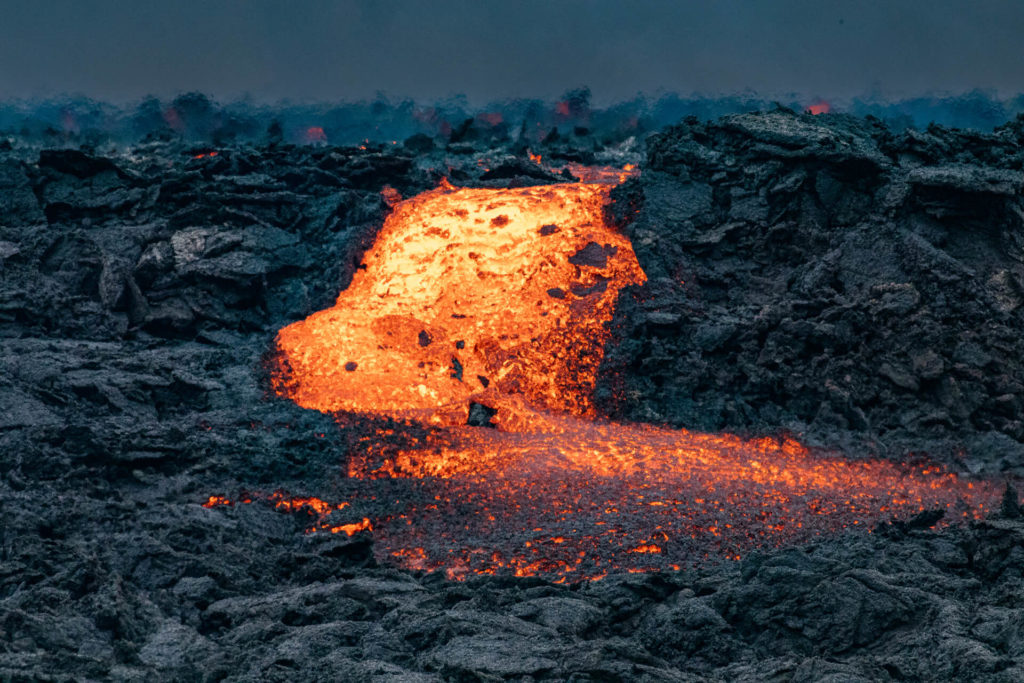
Photography Tips:
Whether you’re an aspiring landscape photographer or simply an adventurer with a camera, keeping a few key aspects in mind when photographing a volcano will help you capture the immense beauty and dramatic intensity of these geological wonders.
- Different angles: When photographing the eruption, vary the angles to convey the scale and impact. Experiment with higher elevations to place the eruption in the context of the landscape. Photograph from lower perspectives to highlight foreground elements such as lava formations and rocks. Remember that safety is essential; avoid getting too close to the lava. Pay special attention to recent lava flows that may appear to have solidified but may have magma hidden underneath, posing a risk.
- Different focus distances: use a variety of focal lengths to create different compositions. Wide-angle lenses (e.g. 16-35 mm) are ideal for photographing extensive eruption landscapes and conveying the vastness of the volcanic landscape. Telephoto lenses (e.g. 70-200 mm) allow you to zoom in on specific volcanic details, such as lava flows or ash clouds, from a safe distance.
- Different times of day and lighting conditions: Photograph at different times of the day to capture the eruption in different lighting conditions. The golden hour and blue hour at sunrise and sunset provide soft, warm light that adds a magical touch to your images. Shooting at night offers the opportunity to capture the fascinating glow of the lava flows against a dark sky. An overcast sky can create a moody atmosphere, while sunny conditions bring out the intensity of the eruption.
Drone Photography
Drone photography has revolutionized our perception of the world, providing stunning aerial views that were previously only accessible to those who could afford a helicopter… or to the birds. When documenting volcanic eruptions, drones offer a unique way to safely capture the magnitude and intensity of the event. Whether you’re an experienced drone enthusiast or a curious novice, you’ll be fascinated by the extraordinary perspectives they offer. However, using drones in dynamic and dangerous environments requires careful consideration of several factors.
- Research and permits: Before using a drone, find out about local laws and regulations governing drone flights in your area. Obtain any necessary permits or authorizations from the relevant authorities if required.
- Safety and flight restrictions: Fly your drone at a safe distance from the eruption site to avoid interference with volcanic activity and other aerial operations. Drones should not fly higher than 120 metres above the ground and must always give way to other aircraft, and should not be flown outside the line of sight (BVLOS). Be aware that weather conditions (e.g. high winds) may affect your ability to control the drone.
As the operator of the drone, you are responsible for any damage that may result from its use.
- Be aware of potential hazards such as volcanic ash or gases that may affect drone flight and visibility; problems have also been reported with drone compasses and GPS systems in volcanic environments.
- Take enough SD cards with you: This is important if you are recording content that you do not want to lose, but it is essential if you are recording footage of a volcanic eruption as it would be almost impossible to recover the footage if something went wrong. You should also take as many spare batteries as possible.
- Flying a drone over a crater or fissure always involves a certain risk: the temperature of the outflowing lava is around 1200 degrees.
Once the practical aspects have been taken care of, you can focus on the technical aspects and on your gear.
- Use a reliable drone with a high-resolution camera that can capture detailed images and videos. Consider a drone with obstacle avoidance technology for added safety.
- Set your camera to shoot in RAW format for maximum flexibility in post-processing.
- Experiment with different shutter speeds to capture lava flow motion or gas plumes.
- Neutral density philters (ND) can help control exposure in bright volcanic conditions. They are particularly useful for slowing down the shutter speed to make the lava flow or ash cascades quieter.
- Volcanic environments often have unique lighting conditions due to the presence of ash and gas. Adjust your white balance settings to compensate for these variations.
- Use the GPS and the live view of the drone to carefully compose your shots. Consider the volcano’s surroundings and record the landscape to give context to your volcano shots.
- Use the drone’s gimbal or stabilization features to ensure steady footage, especially when flying near volcanic vents where turbulence can be a problem.
If possible, use your drone flight planning software to create precise flight routes and waypoints so you can safely capture the shots you want.
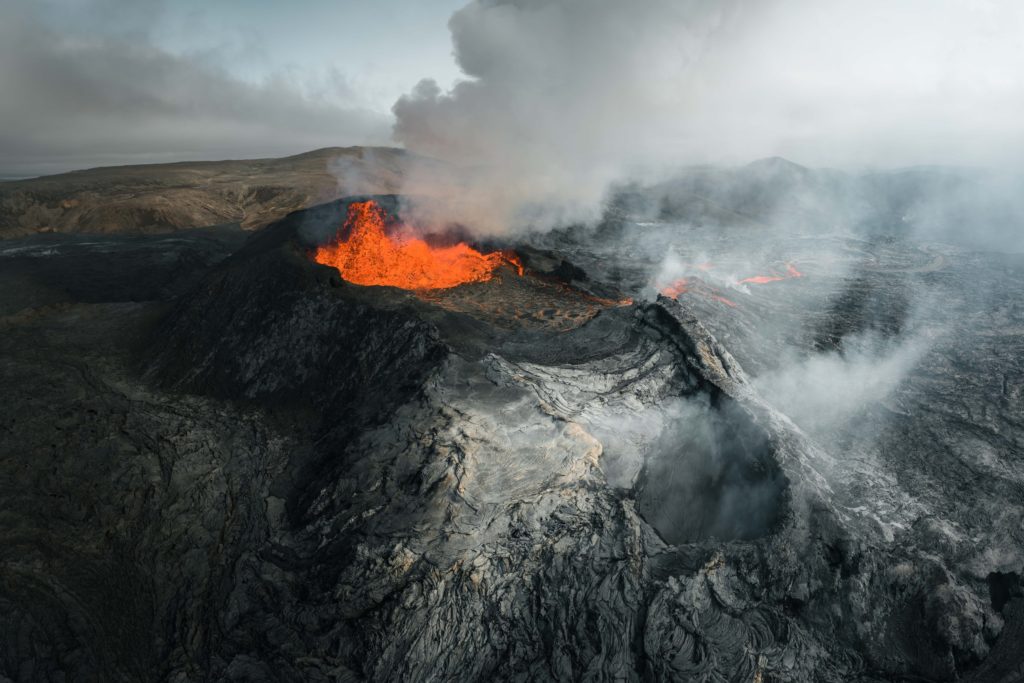
Aerial Photography
Photographing an active volcano from a plane or helicopter is a unique and exciting experience, but it comes with several technical challenges and considerations. Here are the most important technical aspects to consider:
- Use a high-quality camera and/or video camera with different lenses to take both wide-angle and close-up shots. Despite the considerable potential of lenses currently mounted on mobile phones and action cameras, a DSLR or mirrorless camera with interchangeable lenses is ideal.
- Volcanic flights can be turbulent. Make sure your camera has stabilization technology or a gimbal to ensure sharp images, especially in low light or when using long lenses.
- Mastering the camera settings is the be-all and end-all. Use fast shutter speeds, ideally 1/500 or slower, to counteract aircraft vibrations and get sharp shots. Experiment with slower shutter speeds to artfully capture the movement of the lava. Choose a small aperture (higher f-number) for a large depth of field to capture volcanic landscapes in detail. Adjust the aperture for low light conditions or creative effects. Select a low ISO setting to reduce image noise, especially in low light conditions such as dawn or dusk, to maintain image sharpness in volcano photography.
- You can use different lenses to capture sweeping volcanic landscapes or zoom in on specific features. Enhance your shots with a polarising philter to reduce glare, intensify colours, and break through the atmospheric haze. Consider a UV filter for lens protection and capture clear shots in unpredictable conditions for volcano photography.
- Rely on manual focus for aerial photography over active volcanoes, as autofocus can have problems, especially in turbulent conditions. Adjust the focus precisely. Volcanic landscapes are challenging to meter because of the strong contrasts and fluctuations in light. Use exposure compensation to balance brightness in scenes and ensure a dynamic range and vivid detail in ever-changing volcanic environments.
Photographing a volcanic eruption is a rare experience that requires both technical skill and respect for the forces of nature. Always keep safety in mind, follow official instructions, and be prepared for difficult conditions when documenting these awe-inspiring events. Whether on the ground, with drones, or through aerial photography, always approach the volcanic environment with the utmost respect and your images will stand as amazing testaments to nature’s awe-inspiring fury.
Jessica Giuffrida
I’m Jessica Giuffrida, an avid reader and knowledge enthusiast who is always seeking new insights and perspectives. Welcome to my blog!



